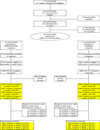Effects of the communities that care prevention system on youth reports of protective factors
- PMID: 25366931
- PMCID: PMC4418962
- DOI: 10.1007/s11121-014-0524-9
Effects of the communities that care prevention system on youth reports of protective factors
Abstract
Many interventions seeking to reduce problem behaviors and promote healthy youth development target both risk and protective factors, yet few studies have examined the effect of preventive interventions on overall levels of protection community wide. In a community-randomized controlled trial, this study tested the effect of Communities That Care (CTC) on protective factors in 24 communities across seven states. Data on protective factors were collected from a panel of 4407 youths in CTC and control communities followed from grade 5 through grade 8. Hierarchical linear modeling compared mean levels of 15 protective factors derived from the social development model in CTC and control communities in grade 8, adjusted for individual and community characteristics and baseline levels of protective factors in grade 5. Global test statistics were calculated to examine effects on protection overall and by domain. Analyses across all protective factors found significantly higher levels of overall protection in CTC compared to control communities. Analyses by domain found significantly higher levels of protection in CTC than control communities in the community, school, and peer/individual domains, but not in the family domain. Significantly higher levels of opportunities for prosocial involvement in the community, recognition for prosocial involvement in school, interaction with prosocial peers, and social skills among CTC compared to control youth contributed to the overall and domain-specific results. This is consistent with CTC's theory of change, which posits that strengthening protective factors is a mechanism through which CTC prevents behavior problems.
Conflict of interest statement
The authors declare that they have no conflict of interest.
Figures
Similar articles
-
Evaluation of Community-Level Effects of Communities That Care on Adolescent Drug Use and Delinquency Using a Repeated Cross-Sectional Design.Prev Sci. 2016 Feb;17(2):177-87. doi: 10.1007/s11121-015-0613-4. Prev Sci. 2016. PMID: 26462492 Free PMC article.
-
Effects of Communities That Care on Males' and Females' Drug Use and Delinquency 9 Years After Baseline in a Community-Randomized Trial.Am J Community Psychol. 2015 Dec;56(3-4):217-28. doi: 10.1007/s10464-015-9749-4. Am J Community Psychol. 2015. PMID: 26377418 Free PMC article. Clinical Trial.
-
Aggregating indices of risk and protection for adolescent behavior problems: the Communities That Care Youth Survey.J Adolesc Health. 2007 Jun;40(6):506-13. doi: 10.1016/j.jadohealth.2006.09.002. Epub 2006 Oct 27. J Adolesc Health. 2007. PMID: 17531756
-
Youths and communities: toward comprehensive strategies for youth development.Soc Work. 1997 Sep;42(5):483-93. doi: 10.1093/sw/42.5.483. Soc Work. 1997. PMID: 9311305 Review.
-
The importance of the community context in the epidemiology of early adolescent substance use and delinquency in a rural sample.Am J Community Psychol. 2009 Dec;44(3-4):287-301. doi: 10.1007/s10464-009-9258-4. Am J Community Psychol. 2009. PMID: 19838797 Free PMC article. Review.
Cited by
-
London Education and Inclusion Project (LEIP): Results from a Cluster-Randomized Controlled Trial of an Intervention to Reduce School Exclusion and Antisocial Behavior.J Youth Adolesc. 2017 Mar;46(3):538-557. doi: 10.1007/s10964-016-0468-4. Epub 2016 Mar 23. J Youth Adolesc. 2017. PMID: 27007714 Free PMC article. Clinical Trial.
-
Risk and protective factors related to youth firearm violence: a scoping review and directions for future research.J Behav Med. 2019 Aug;42(4):706-723. doi: 10.1007/s10865-019-00076-7. Epub 2019 Aug 1. J Behav Med. 2019. PMID: 31367936 Free PMC article.
-
The Pivotal Role of Prevention Science in This Syndemic.Prev Sci. 2021 Jan;22(1):94-99. doi: 10.1007/s11121-020-01180-w. Epub 2020 Nov 19. Prev Sci. 2021. PMID: 33215309 Free PMC article.
-
The German Communities That Care Youth Survey: dimensionality and validity of risk factors.Front Public Health. 2024 Sep 30;12:1472347. doi: 10.3389/fpubh.2024.1472347. eCollection 2024. Front Public Health. 2024. PMID: 39403431 Free PMC article.
-
Change in Protective Factors Across Adolescent Development.J Appl Dev Psychol. 2015 Sep-Oct;40:26-37. doi: 10.1016/j.appdev.2015.04.006. J Appl Dev Psychol. 2015. PMID: 26405365 Free PMC article.
References
-
- Akers RL. Deviant behavior: A social learning approach. 2nd ed. Belmont, CA: Wadsworth Publishing Company; 1977.
-
- Arthur MW, Ayers CD, Graham KA, Hawkins JD. Mobilizing communities to reduce risks for drug abuse: A comparison of two strategies. In: Bukoski WJ, Sloboda Z, editors. Handbook of drug abuse prevention. Theory, science and practice. New York: Kluwer Academic/Plenum; 2003. pp. 129–144.
-
- Arthur MW, Glaser RR, Hawkins JD. Steps towards community-level resilience: Community adoption of science-based prevention programming. In: Peters RD, Leadbeater B, McMahon RJ, editors. Resilience in children, families, and communities: Linking context to practice and policy. New York: Kluwer Academic/Plenum; 2005. pp. 177–194.
-
- Arthur MW, Hawkins JD, Pollard JA, Catalano RF, Baglioni AJ., Jr Measuring risk and protective factors for substance use, delinquency, and other adolescent problem behaviors: The Communities That Care Youth Survey. Evaluation Review. 2002;26:575–601. - PubMed
-
- Bowers EP, von Eye A, Lerner JV, Arbeit MR, Weiner MB, Chase P, Agans JP. The role of ecological assets in positive and problematic developmental trajectories. Journal of Adolescence. 2011;34:1151–1165. - PubMed
Publication types
MeSH terms
Grants and funding
LinkOut - more resources
Full Text Sources
Other Literature Sources
Medical



